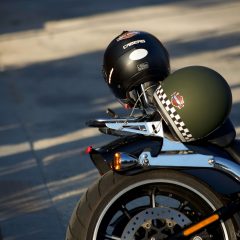
7 Top Motorcycle Accessories
With Christmas just around the corner, you might be wondering what to get your favourite motorcycle enthusiast or even a little something for yoursel...
 Phoenix Motorcycle Training LTD
Phoenix Motorcycle Training LTD
 Phoenix Motorcycle Training LTD
Phoenix Motorcycle Training LTD

Motorcycle safety for cars and drivers could be better. It’s not just down to motorcyclists to keep themselves safe on the road. We all have a duty of care to each other.
Two thirds of fatal accidents involving motorcyclists happen on rural roads. And 39% of motorcyclist fatalities involve a car. UK drivers are some of the safest in the world, but we could drive a little better for our friends and family on two wheels. It’s one of the reasons behind the ‘travel like you know them’ road safety campaign in early 2023.
Passing distances, staying aware of blind spots, and double-checking for motorcyclists at intersections are a few of the obvious ways drivers can improve safety for riders. Read on for the best common-sense and not-so-obvious motorcycle safety tips for car drivers.
Accident figures for motorcyclists are sobering. Numbers went down in 2020. No doubt, less traffic overall through the COVID-19 years was part of the reason. Since we’ve returned to our usual lifestyles, figures have risen again. In 2022, total accidents involving a motorcyclist reached 16,943—that’s roughly the same as 2018’s numbers.
All of us, motorcyclists, cyclists, car and truck drivers can improve motorcycle safety. The following motorcycle safety tips for car drivers will help you do just that.
Remember that motorcyclists are allowed to filter past slower vehicles. If you notice a motorcycle coming up behind you in a line of traffic, make room for them. It helps you get where you are going faster too.
If you see a motorcyclist indicating, make sure they’re actually turning before pulling out, passing, or if you’re following an indicating motorcyclist, increase the distance between you so you’ll have more reaction time when they turn.
Motorcyclists crashing into right-turning cars and vehicles can be nasty. So take extra care at junctions. Always look. And then look again for motorcyclists.
Tiny rural B roads can be pockmarked with broken tarmac, potholes and clumps of mud from tractors. All of these may mean a motorcycle has to move across their lane to avoid the hazard. Riders are safer doing this when larger traffic is travelling at a speed they can easily react to and accommodate their moves at.
Motorcycle riders can be harder to see. They’re smaller and sometimes blend into the background in rear vision mirrors. Taking a brief moment to turn and check makes the roads safer for riders.
Back in January 2022, the UK Highway Code had an update. The idea behind the changes was to keep vulnerable road users safer from cars, vans and trucks. It’s a fair point too. Motorcycle safety for cars, vans and larger vehicles should be a priority. Drivers have a little more protection from airbags, the big metal box around them, and other vehicle safety technology. We should look out for vulnerable motorcycle and scooter riders as well as cyclists.
Rules 204 to 225 of the Highway Code had a refresh. Drivers are advised to take extra care, look out for motorcyclists and cyclists in traffic and give them a little more space in traffic. This excerpt from Rule 211 about motorcycle safety for cars gives a few additional tips:
“It is often difficult to see motorcyclists and cyclists, especially when they are waiting alongside you, coming up from behind, coming out of or moving off from junctions, at roundabouts, overtaking you or filtering through traffic. Always look out for them before you emerge from a junction; they could be approaching faster than you think.” – Highway Code Rule 211
Aside from taking your Compulsory Basic Training to learn to ride a motorcycle yourself, how do you really appreciate the challenges of motorcyclists? There are plenty of Advance Rider Courses for motorcyclists to improve skills, but what about Advanced Driver Courses?
Biker Down! will give you a great appreciation of the kinds of hazards bikers face every day. It will also give you the skills and knowledge you need to respond well if you’re first on the scene of a motorcycle accident. You can be a car driver, motorcyclist or any other type of road user to take this course.
IAM RoadSmart provides advanced driver courses for new licence holders, experienced drivers and mature drivers. These courses kick-off with an assessment and then focus on building strengths and addressing driving weaknesses. They’ll make you a safer driver for motorcyclists and other road users too.
The DVSA offers ways to improve motorcycle safety for car drivers too. Pass Plus training will help you to become a safer and more competent driver. Meeting the required standard in all six modules could also land you with cheaper insurance premiums.
Road safety is a big deal. Around 5 people die each day on UK roads and another 82 are seriously injured. That’s not great. All of us, car drivers, motorcycle riders, van and truck professionals can make the roads safer if we take time to show we care about the people sharing the road with us. Learning about motorcycle safety for cars improves road safety for everyone.

With Christmas just around the corner, you might be wondering what to get your favourite motorcycle enthusiast or even a little something for yoursel...

If you love motorcycle riding, you’ve probably daydreamed about riding a motorbike for a living. A professional racer or stunt rider is OK for some...

Getting a UK motorcycle licence can seem a complicated process. Particularly when compared to a driving licence for a car. Whether you choose the pro...
This website uses cookies to personalise content, ads, and analyse traffic, sharing data with partners who may combine it with other information. See our Privacy Policy for more information.